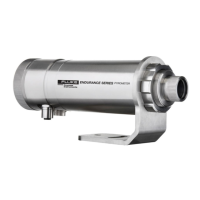5.6 Inputs
5.6.1 Trigger
The trigger input can be used as switch to initiate one of the following:
• Restarting the signal processing, see section 6.3 Post Processing, page 55.
• Toggling the pointing device (LED, laser, camera) between on/off, see ASCII command XL
The trigger function is activated by shorting the external input to digital ground (pin L). The shorting can be done
with an external switch, relay, transistor, or TTL gate.
Figure 5-8: Wiring the Trigger Input
5.6.2 Analog Input
The analog input is galvanically isolated and processes currents in the range of 0 to 20 mA or 4 to 20 mA. The
following functions can be executed via the analog input:
• Setting the emissivity value (preferential for sensors in 1-color mode)
• Setting the slope value (for sensors in 2-color mode)
• Setting the temperature for the background temperature compensation
• Reading the current from an external device using the ASCII command <IN>
Figure 5-9: Wiring the Analog Input
5.6.2.1 Emissivity/Slope Setting
The analog input can be configured to accept an analog current to provide real time emissivity setting for sensors
in 1-color mode (or slope for sensors in 2-color mode). The following table shows the relationship between input
current and emissivity:
Table 5-2: Ratio between Analog Input Current and Emissivity (Example)
Use the adequate ASCII commands to configure the analog input, see section 14.5.2 Emissivity Setting, page 122
and section 14.5.3 Background Temperature Compensation, page 122.

